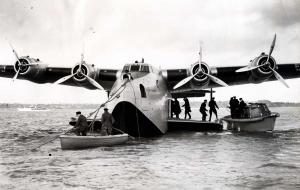Region celebrates first seaplane flight
Seaplanes are the dinosaurs of commercial aviation history. They once ruled the skies but became almost extinct during the course of evolution.
The first seaplane in history took off from the waters of Étang de Berre one hundred years ago, on 28 March 1910. It was a frail-looking machine equipped with a small 50 HP engine. Its designer and pilot, an engineer from Marseille named Henri Fabre, rode it astride, as if riding a winged horse.
Pegasus, however, was not the name Henri Fabre chose for his "hydro-aeroplane." The 27-year old engineer preferred to name his invention Le Canard (The Duck).
On that first flight, Le Canard flew a distance of about 500 metres, twice as far as the Wright brothers' aeroplane seven years earlier at Kitty Hawk, North Carolina. On the same day, Fabre, who had never flown before, not even as a passenger, performed five other flights and made an elegant landing—or "alighting" which is more proper for seaplanes—in the Martigues marina.
Henri Fabre, whose feat will be celebrated throughout the region this week-end, opened the way for long-distance commercial flight. A good decade before regular aircrafts, seaplanes were to venture across the transatlantic route.
Unaware that it was paying homage to Henri Fabre, Pan American Airlines opened the world's first transatlantic passenger service in 1939, between New York and Marseille. And just as Le Canard had done 29 years earlier, the fabled Yankee Clipper, Boeing's 74-passenger luxury "flying boat", would land on and take off from the waters of Étang de Berre.



